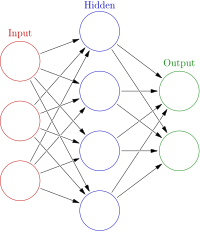
Photo from wikipedia
Background: One of the fields of research in recent years that has been under focused is emotion recognition in electroencephalography (EEG) signals. This study provides a four-layer method to improve… Click to show full abstract
Background: One of the fields of research in recent years that has been under focused is emotion recognition in electroencephalography (EEG) signals. This study provides a four-layer method to improve people's emotion recognition through these signals and deep belief neural networks. Methods: In this study, using DEAP dataset, a four-layer method is established, which includes (1) preprocessing, (2) extracting features, (3) dimension reduction, and (4) emotion identification and estimation. To find the optimal choice in some of the steps of these layers, three different tests have been conducted. The first is finding the perfect window in feature extraction section that resulted in superiority of Hamming window to the other windows. The second is choosing the most appropriate number of filter bank and the best result was 26. The third test was also emotion recognition that its accuracy was 92.93 for arousal dimension, 92.64 for valence dimension, 93.14 for dominance dimension in two-class experiment and 76.28 for the arousal, 74.83 for the valence, and 75.64 for dominance in three-class experiment. Results: The results of this method show an improvement of 12.34% and 7.74% in two- and three-class levels in the arousal dimension. This improvement in the valence is 12.77 and 8.52, respectively. Conclusion: The results show that the proposed method can be used to improve the accuracy of emotion recognition.
Journal Title: Journal of Medical Signals and Sensors
Year Published: 2019
Link to full text (if available)
Share on Social Media: Sign Up to like & get
recommendations!